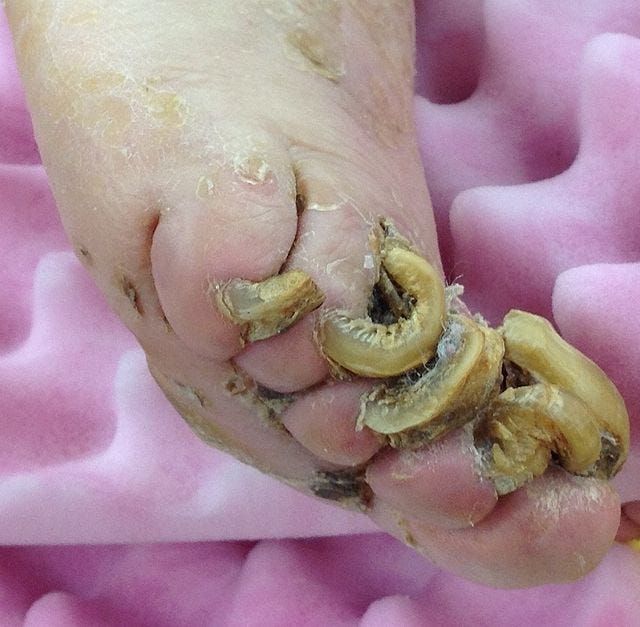Case study
Several months ago, I saw a patient with advanced multiple sclerosis (MS) who had been having increasing difficulty with mobilising and had taken to wearing slippers to shuffle between their wheelchair and their bed or toilet. They complained about painful feet. When I got them onto the examination couch and looked at their feet, they clearly had onychogryphosis.

Prof G’s Commentary
Onychogryphosis is overgrown and neglected toenails. I had to refer this patient to their local podiatry service. Hopefully, they will have regular appointments to have their toenails cut and their feet looked at and maintained in good condition. I anticipate that their walking and mobility will have improved when I see this patient next.
One of the hand and arm functions that came up as important in our surveys to support our #ThinkHand campaign was the ability to cut your toenails. To maintain this function, you need good hand function, preserved coordination and joint position sensation, reasonable eyesight and enough musculoskeletal flexibility to reach your toenails. For example, too much lower limb spasticity could prevent you from reaching your feet. Similarly, a severe tremor may make using nail clippers difficult.
I did a survey three years ago, and close to one in five people who completed the survey couldn’t cut their toenails. I am acutely aware of how frustrating this is. Since my pedestrian road traffic accident in 2020 and the damage to my right hip, I can’t flex and externally rotate my right hip very well, which is very painful. This makes it difficult for me to reach my right foot easily; it is painful and awkward. As a result, I tend to neglect or delay cutting my toenails. My feet were so bad a few months ago my wife booked me into our local nail bar for a pedicure. Therefore, I can only imagine how frustrating this must be for people with MS.
People who completed the survey gave many reasons why they had difficulty cutting their toenails. The reasons included weakness, incoordination, reduced sensation in their fingers, poor vision, tremors, reduced flexibility, balance problems and fatiguability.
Podiatry is one of the NHS’s essential services. And most NHS podiatry services allow self-referral, which prevents delays. In addition, in many areas, podiatrists may even do home visits.
Please be aware that onychogryphosis is not only unsightly, but it may also be painful, interferes with walking and balance, and is an underappreciated risk factor for falls.
Onychogryphosis and poor foot hygiene are clinical signs I use to check for neglect. The others are pressure sores, poor oral and general hygiene, unkempt hair, intertrigo, under or overweight, social isolation, poverty, severe cognitive impairment and depression. An important role of healthcare professionals is patient advocacy and making sure patients are safe. A neglected patient with MS, be it due to disability, poverty, mental health issues, or deliberate poor care, becomes our problem when we detect it. As HCPs, we have a responsibility to help.
How many of you think you are being neglected or have been neglected in the past? If yes, what have you done about it?
I am sure many commentators will criticise me for writing about the underbelly of having MS, but nothing will be done to prevent and sort out these problems unless we discuss these things. Do you agree?
Subscriptions and donations
Paid subscriptions to MS-Selfie are being used to administer the Newsletter and associated MS-Selfie microsite, which is now open to all readers. At the request of several readers, I have now added the option of making a one-off donation. To keep this initiative open to all readers, I would appreciate it if those who can afford a subscription to subscribe. For active paying subscribers, thank you; your contribution is much appreciated. Because of the falloff in paying subscribers, I am considering returning to a paywall that will give paying subscribers six months of unlimited access to all newsletters. At the same time, free subscribers will have a wait to access the newsletters later, not as an email, but on the substack site.
General Disclaimer: Please note that the opinions expressed here are those of Professor Giovannoni and do not necessarily reflect the positions of Barts and The London School of Medicine and Dentistry nor Barts Health NHS Trust. The advice is intended as general and should not be interpreted as personal clinical advice. If you have problems, please tell your healthcare professional, who will be able to help you.















Share this post